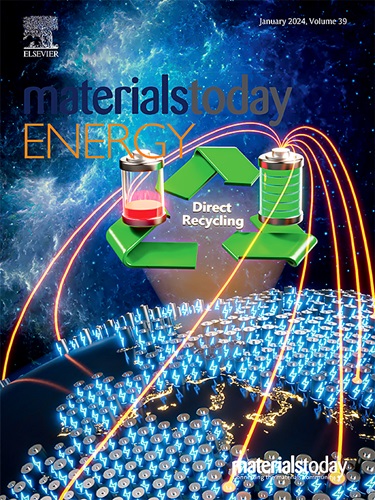Ultrahigh efficiency and energy density in tri-layered ferroelectric polymer composites utilizing ultralow loading of micro-sized plates
IF 8.6
2区 材料科学
Q1 CHEMISTRY, PHYSICAL
引用次数: 0
Abstract
Ferroelectric-based composites have demonstrated tremendous potential in electrostatic capacitor owing to their exceptional dielectric characteristics. However, it is extremely challenging to attain desirable energy density () and above 95% efficiency () under low electric fields in the ferroelectric polymer-based composites because of the dominating electrical conduction loss. Herein, ferroelectric polymer composites consisting of SrTiO@SiO plates/(PVDF--HFP) as the inner layer and polycarbonate (PC) as the outer polymer layers are elaborately proposed. The vital role of the multiple interlaminar interfaces (electrode/dielectric interface and interlayer interface) on the reduction of conduction loss and improvement of corresponding energy storage properties of the ferroelectric polymer is verified by experimental and theoretical simulations. The resulting composite with an ultralow loading of SrTiO@SiO plates (0.5 vol%) displays a record high capacitive performance (∼8.73 J/cm) at above 95% under the low electric field of 280 MV/m, indicating an enormous ∼118% increment of the maximal over the commercial bench-mark biaxially oriented polypropylene (∼4 J/cm) and far outperforming those of the polymer-based dielectrics reported to date. Along with fast discharge time (9 ns), this contribution presents a versatile and competitive technology for fabricating composites with exceptional energy storage capabilities operating under low electric fields.利用微型板的超低负载实现三层铁电聚合物复合材料的超高效率和能量密度
铁电基复合材料因其优异的介电特性而在静电电容器领域展现出巨大的潜力。然而,由于电导损耗占主导地位,铁电聚合物基复合材料在低电场下要达到理想的能量密度()和 95% 以上的效率()极具挑战性。在此,我们精心提出了以 SrTiO@SiO 板/(PVDF--HFP)为内层、聚碳酸酯(PC)为外层的铁电聚合物复合材料。实验和理论模拟验证了多个层间界面(电极/电介质界面和层间界面)对降低传导损耗和提高铁电聚合物相应储能性能的重要作用。在 280 MV/m 的低电场条件下,SrTiO@SiO 板的超低负载量(0.5 vol%)产生的复合材料的电容性能(∼8.73 J/cm)达到了创纪录的高水平,超过了 95%,这表明其最大电容性能比商业基准双向拉伸聚丙烯(∼4 J/cm)提高了 118%,远远超过了迄今报道的聚合物基电介质。由于放电时间短(9 ns),该研究成果为在低电场下制造具有超强储能能力的复合材料提供了一种多用途、有竞争力的技术。
本文章由计算机程序翻译,如有差异,请以英文原文为准。
求助全文
约1分钟内获得全文
求助全文
来源期刊

Materials Today Energy
Materials Science-Materials Science (miscellaneous)
CiteScore
15.10
自引率
7.50%
发文量
291
审稿时长
15 days
期刊介绍:
Materials Today Energy is a multi-disciplinary, rapid-publication journal focused on all aspects of materials for energy.
Materials Today Energy provides a forum for the discussion of high quality research that is helping define the inclusive, growing field of energy materials.
Part of the Materials Today family, Materials Today Energy offers authors rigorous peer review, rapid decisions, and high visibility. The editors welcome comprehensive articles, short communications and reviews on both theoretical and experimental work in relation to energy harvesting, conversion, storage and distribution, on topics including but not limited to:
-Solar energy conversion
-Hydrogen generation
-Photocatalysis
-Thermoelectric materials and devices
-Materials for nuclear energy applications
-Materials for Energy Storage
-Environment protection
-Sustainable and green materials
 求助内容:
求助内容: 应助结果提醒方式:
应助结果提醒方式:


